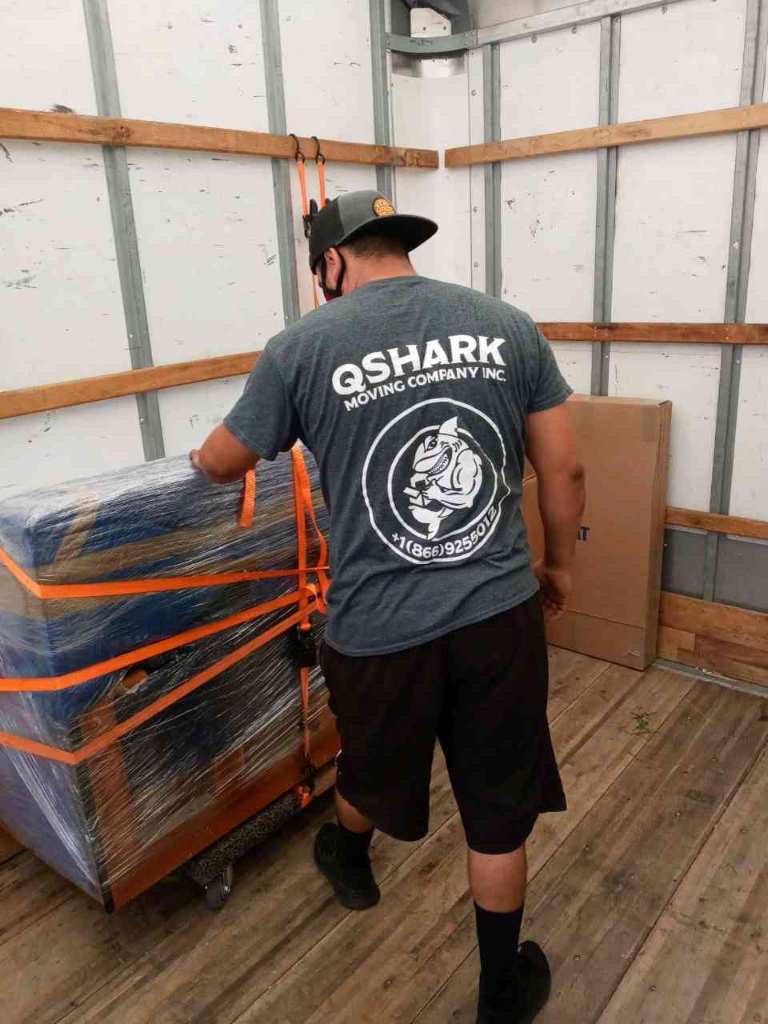How Do Movers Pack Clothes?

When planning a move, many wonder, “How do professional movers pack clothes?” This is a common question considering the value and volume of clothing items during a move. At QShark Moving, we understand these concerns and offer a strategic approach to packing clothes, ensuring they arrive at your new home in top condition. Here’s a step-by-step guide on how our professional movers in San Diego, Orange County, and Rancho Cucamonga handle this crucial task.
Step 1: Initial Assessment
Our journey begins with an initial assessment of your clothes. This step is crucial for determining the packing materials needed and creating a strategic packing plan. As one of the top movers in the industry, QShark Moving doesn’t take a one-size-fits-all approach to packing. We assess your clothes’ type, quantity, and condition to provide a personalized packing solution.
Step 2: Gathering Packing Materials
Once we understand the nature and volume of your clothes, we gather the appropriate packing materials. These typically include:
- Wardrobe Boxes: These are tall, durable boxes equipped with a hanging rail. They’re perfect for transporting hanging clothes without removing them from their hangers.
- Standard Moving Boxes: Our professional movers use standard moving boxes of varying sizes for folded clothes.
- Packing Paper & Bubble Wrap: To add an extra layer of protection, we may use packing paper or bubble wrap to line the boxes.
- Packing Tape & Markers: These are essential for sealing and labeling your boxes.
Step 3: Packing Hanging Clothes
Packing hanging clothes is a task that requires care and attention. Here’s how our best movers handle this process:
- Group Clothes: We group your hanging clothes by length and type. For instance, long dresses are grouped together to avoid dragging on the bottom of the wardrobe boxes.
- Place in Wardrobe Boxes: We then carefully transfer your clothes, still on their hangers, directly into the wardrobe boxes. The in-built rail mimics your closet, making this a seamless process.
- Secure & Seal Boxes: We securely close and seal the wardrobe boxes after ensuring your clothes are neatly packed.

Step 4: Packing Folded Clothes
The process for packing folded clothes is slightly different. Here’s how our team, offering top-notch packing services, does it:
- Line Boxes: We start by lining the moving boxes with packing paper or bubble wrap. This layer cushions your clothes and protects them from any dirt or dust.
- Pack Clothes: We then neatly stack your folded clothes into the boxes, careful not to overpack. This ensures your clothes don’t get crushed during the move.
- Seal & Label Boxes: Finally, we securely seal the boxes and label them according to the room or clothing type. This makes unpacking much easier.
Step 5: Special Clothing Items
At QShark Moving, we understand that some clothing items may require special attention. Whether it’s a wedding dress, expensive suit, or vintage clothing, our professional movers are trained to handle these items with the utmost care. We use additional protective materials and specific packing techniques to ensure these items are safely packed for the move.
In conclusion, understanding how movers pack clothes can provide peace of mind and help ensure your move goes smoothly. The team at QShark Moving follows these steps meticulously, treating your clothes with the care they deserve. Their expertise in packing, coupled with their commitment to providing superior moving services, sets them apart from other movers.

Step 6: Loading and Transporting Clothes
Once your clothes are securely packed, the next step is the actual move. Whether you’re moving within the same city or long-distance, choosing a reliable company like QShark Moving is crucial. Our team of local movers and long-distance movers are trained to handle your packed clothes with care during the loading, transport, and unloading phases.
- Loading: Our movers carefully load your packed clothes into the moving truck, placing heavier boxes at the bottom and lighter or fragile ones on top. This strategic placement ensures your clothes remain in top condition during the move.
- Transporting: Whether you’re moving locally or across the country, you can trust our team to transport your belongings safely to your new home.
- Unloading: Upon reaching your new home, our team unloads your clothes with the same care and attention to detail. Whether you’re moving to a high-rise apartment in San Diego or a quiet suburban home in Orange County, we ensure your clothes are unloaded and placed in your desired location.
Step 7: Unpacking and Organizing Clothes
The final step in our process involves unpacking and organizing your clothes in your new home. Our team will assist if you’ve opted for our comprehensive packing and unpacking services. From removing your clothes from the boxes to arranging them in your closets and drawers, we handle each task with care and efficiency. This is just one of the many reasons why we’re recognized as the best movers in the industry.
In summary, QShark Moving’s step-by-step approach to packing clothes showcases the care and professionalism we bring to each move. As a leading moving company offering a range of services – from office moving and piano moving to day labor – we strive to make your move as smooth as possible. Whether you’re planning a local or long-distance move, consider QShark Moving for your packing and moving needs. Our commitment to quality and customer satisfaction makes us the ideal partner for your moving journey.
Step 8: Disposing of Packing Materials
One of the many things that sets QShark Moving apart as one of the top movers in the industry is their commitment to a comprehensive service. After your clothes have been unpacked and organized, they don’t just leave you with the task of dealing with the used packing materials. Instead, the QShark Moving team takes care of disposing of these materials, leaving your new space clean and uncluttered. These small but significant details make them the go-to professional movers in San Diego, Orange County, and Rancho Cucamonga. How do movers pack clothes?
Step 9: Post-Move Review
At QShark Moving, we understand that the process doesn’t end once the last box is unpacked. That’s why we encourage a post-move review. This review serves a dual purpose: it allows you to reflect on the quality of service you received and provides invaluable feedback for our team.
As one of the best movers in the business, we value your feedback. It helps us continue to refine and improve our moving service, ensuring we maintain our high standards. If your experience was positive, leaving a review can also assist others in their search for a reliable moving company.
In conclusion, understanding how movers pack clothes can help demystify the moving process, making it less daunting and more manageable. By trusting a reputable moving company like QShark Moving, you can rest assured that each step – from the initial packing to the final unpacking – will be handled with the utmost professionalism and care. So, whether you’re planning a local or long-distance move, turn to QShark Moving, a company that prides itself on its commitment to quality, customer satisfaction, and comprehensive moving services.


